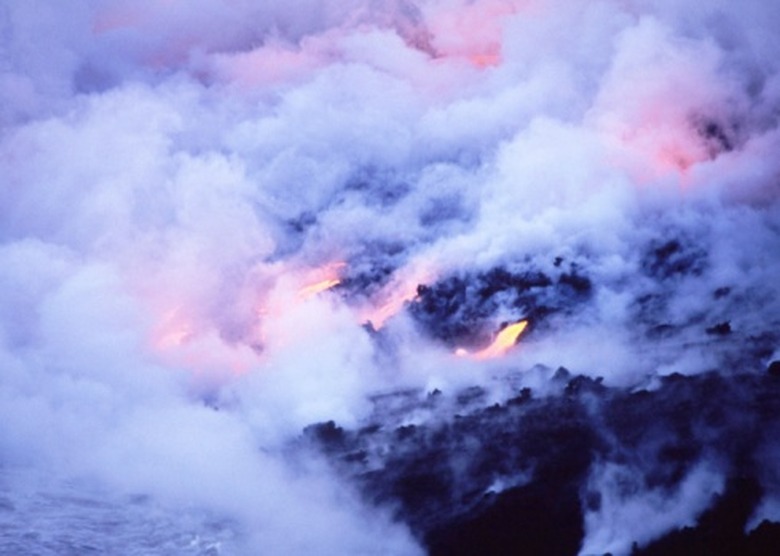The Different Properties Of The Asthenosphere & The Lithosphere
The asthenosphere and lithosphere compose the outermost concentric layers of the Earth: The first encompasses much of the upper mantle, while the lithosphere includes the uppermost mantle and the overlying crust, welded together in the form of tectonic plates. Though humans are naturally limited in their ability to explore the upper mantle – stuck as they are on that narrow outside crust of the planet – the behavior of seismic waves and other evidence has revealed fundamental differences in the physical properties of the asthenosphere and lithosphere. These differences help explain the movement and arrangement of the ocean basins and continents.
The Layers of the Earth
The Layers of the Earth
Before digging into the asthenosphere and lithosphere, let's break down the basic anatomy of the planet. Imagine the Earth as a great big blue round fruit. Four basic layers compose that planetary fruit. There's the very center; the inner core, thought to be a roughly 900-mile-wide solid mass of iron and some nickel. Beyond this lies the outer core, also iron-dominated but – in contrast to the inner core it surrounds – molten (or liquid). The mantle, the most extensive layer of the planet, lies above the outer core; mantle thickness averages about 1,800 miles. Skimming over the mantle as the "fruit's" skin is the comparatively thin crust, which encompasses everything at the Earth's surface – from ocean depths to high mountains – but which contributes less than 1 percent of planetary volume.
The Asthenosphere
The Asthenosphere
Geologists divide the Earth's mantle into several sublayers, the deepest of which is the mesosphere, the base of which borders the outer core; the mesosphere, which you can think of as the lower mantle, is likely rigid. The asthenosphere (finally!) lies above the mesosphere in the upper mantle, stretching from about 62 miles to 410 miles deep. The rock of the asthenosphere – primarily peridotite – is mostly solid, but because it's under such high pressure it flows like tar in plastic (or ductile) fashion at a rate of perhaps an inch or two per year. (This mechanical weakness explains this zone of the mantle's name: Asthenosphere means "weak layer.") Convective currents roil the asthenosphere; hot, less-dense upwellings transporting heat from the interior toward the surface balanced by cool (and therefore denser) downwellings.
The Lithosphere
The Lithosphere
The lithosphere encompasses the very top of the mantle above the asthenosphere as well as the overlying crust. In comparison to the hot, fluid asthenosphere below, the lithosphere is cool and rigid, and rather than one continuous "rind" comes broken into a jigsaw pattern of lithospheric (or tectonic) plates.
You can divide the lithosphere's crust into two varieties. Oceanic crust is relatively thin and dense, dominated by basaltic rock rich in silica and magnesium. Continental crust is lighter and thicker, made up mainly of granitic rocks dominated by silica and aluminum. The crust extends some 2 to 6 miles beneath ocean basins and as far as 50 miles beneath major mountain belts on the continent before transitioning to the iron- and magnesium-rich peridotite of the upper mantle. That boundary between crustal and mantle rocks is named for the scientist (a meteorologist, actually) who helped discover it: It's called the Mohorovicic discontinuity, often (thankfully) shortened to the Moho.
While heat spreads quickly in the asthenosphere by convection, the cooler, rigid rock of the lithosphere transfers heat much more slowly by conduction.
Plate Tectonics
Plate Tectonics
The asthenosphere and lithosphere's physical properties help establish the fundamental forces that move and shape the features composing the surface of the Earth, described in the theory of plate tectonics. The hot, flowing asthenosphere – which remains hot and flowing because of the convection of heat from the Earth's innards – provides a lubricating layer on which the rigid plates of the lithosphere can slide. Magma rises from the asthenosphere to the surface at mid-ocean ridges where tectonic plates diverge, forming new basaltic oceanic crust. This fresh crust spreads from either side, cooling and becoming more dense as it moves away from the mid-ocean ridge. Where an oceanic plate collides with a less-dense plate – which could be younger oceanic crust or continental crust, always lighter than the oceanic kind – it plunges underneath it, or subducts, and is essentially recycled into the mantle. While geoscientists continue to debate the primary force driving plate movement, a prevailing theory suggests it stems from a subducting slab of ocean crust dragging the rest of the plate behind it.
References
- Windows to the Universe: The Earth's Crust, Lithosphere and Asthenosphere
- U.S. Geological Survey: Earthquake Glossary – Asthenosphere
- University of Michigan: Planet Earth: Probing Beyond the Surface
- The Earth Machine: The Science of a Dynamic Planet; Edmond A. Mathez, James D. Webster
Cite This Article
MLA
Shaw, Ethan. "The Different Properties Of The Asthenosphere & The Lithosphere" sciencing.com, https://www.sciencing.com/different-properties-asthenosphere-lithosphere-8447830/. 22 October 2018.
APA
Shaw, Ethan. (2018, October 22). The Different Properties Of The Asthenosphere & The Lithosphere. sciencing.com. Retrieved from https://www.sciencing.com/different-properties-asthenosphere-lithosphere-8447830/
Chicago
Shaw, Ethan. The Different Properties Of The Asthenosphere & The Lithosphere last modified March 24, 2022. https://www.sciencing.com/different-properties-asthenosphere-lithosphere-8447830/
